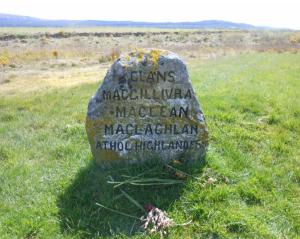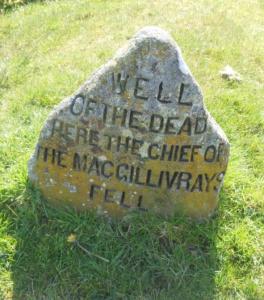A few years ago I enjoyed a bank holiday break in the Inverness area with my wife and kids. I have several lines of family from the vicinity, including Frasers, Camerons, Munros, MacFarlanes and MacGillivrays, who endured many ups and downs in their lives, none perhaps worse than the death of my great great grandmother, Janet MacGillivray (nee Fraser), who committed suicide in 1860 at the Bridge of Tomnahurich in Inverness - she jumped into the Caledonian Canal and drowned, being so distraught at the death of her daughter during childbirth. But the real mission for me was to explore the ancestral area of my MacGillivrays, in the parish of Dores, for the first time.
 My five times great grandfather James MacGillivray, from the farmstead of Dunchea in the parish of Dores, married Ann Cameron on May 1st 1772 at her home in nearby Ruthven, before the couple settled at Dunchea, and later at nearby Bochruben. Although a birth record for James cannot be found, he was likely born in approximately 1750, just a few years after the tragedy of Culloden. On Saturday I spent a couple of hours within the parish, and located the modern farmsteads at Bochruben, Ruthven and Dunchea, within some of the most stunningly bleak landscape I have yet found in the country. There was light snow, and a biting wind - life would not have been easy back in the mid 18th century.
My five times great grandfather James MacGillivray, from the farmstead of Dunchea in the parish of Dores, married Ann Cameron on May 1st 1772 at her home in nearby Ruthven, before the couple settled at Dunchea, and later at nearby Bochruben. Although a birth record for James cannot be found, he was likely born in approximately 1750, just a few years after the tragedy of Culloden. On Saturday I spent a couple of hours within the parish, and located the modern farmsteads at Bochruben, Ruthven and Dunchea, within some of the most stunningly bleak landscape I have yet found in the country. There was light snow, and a biting wind - life would not have been easy back in the mid 18th century.Whilst I have located several vital events shortly after 1750 for members of the MacGillivrays in Dunchea, almost certainly related to my family in such a small area, the records are sadly quite limited before this, mainly because most of the members of the clan back then were adherents to the Scottish Episcopal Church, the former aspect of the Church of Scotland prior to 1690 which continued in an independent form after the Glorious Revolution, and which remained staunchly Jacobite in its support. But what I had not previously realised prior to my visit was just how close to the centre of the MacGillivray clan territory my family locations were.
The chiefs of MacGillivray were based for centuries at Dunmaglass, in the nearby parish of Daviot and Dunlichity, and just over a mile and a half from Ruthven and a couple of miles from Dunchea. In 1746, Alexander MacGillivray of Dunmaglass led the Jacobite charge of the Clan Chattan confederation, of which the MacGillivrays were a long standing member, against the Hanoverian army at Culloden, where he lost his life. Realising just how close my family now was to the clan seat, I wondered what the chances were of my lot being caught up?
 I visited Culloden, and purchased a copy of No Quarter Given: the Muster Roll of Prince Charles Edward Stuart's Army, 1745-46. The list of those who fought for Lady Mackintosh's Regiment, led by MacGillivray, records 26 MacGillivrays and several Camerons. Their places of origin were listed, with four MacGillivrays from Dunmaglass, a John MacGillivray from Aberarder, and a couple of Camerons from Dalcrombie, on the other side of Loch Ruthven from the farmstead at Ruthven where Ann hailed from.
I visited Culloden, and purchased a copy of No Quarter Given: the Muster Roll of Prince Charles Edward Stuart's Army, 1745-46. The list of those who fought for Lady Mackintosh's Regiment, led by MacGillivray, records 26 MacGillivrays and several Camerons. Their places of origin were listed, with four MacGillivrays from Dunmaglass, a John MacGillivray from Aberarder, and a couple of Camerons from Dalcrombie, on the other side of Loch Ruthven from the farmstead at Ruthven where Ann hailed from.James MacGillivray named his first son Donald, and my family, stuck almost religiously to the Scottish naming pattern, and so it is likely that my six times great grandfather was called Donald MacGillivray also. The name was certainly important, with a John MacGillivray also christening his son Donald in 1760 at Dunchea, and a possible sibling to James called Donald, also from Dunchea, marrying an Elizabeth MacGillivray of Gortleg in the same year. Of the 26 MacGillivrays at Culloden, six were Donalds, all from farmsteads in the area. Could one of these have been my ancestor, or related to him perhaps as a cousin?
Whether any of my ancestors were at Culloden I may well never know, but my family in Dores would almost certainly have suffered the same persecutions after Culloden as did all the Highlanders, being prevented from speaking Gaelic, wearing tartan plaids, carrying weapons and more. Having visited the area now, and having realised that many of the homes of those who were confirmed as having fought at Culloden were within walking distance of my ancestors' homes, it is almost certain that they at least knew many of those who fought there. Whilst I have no love for Bonnie Prince Charlie - or any monarch for that matter - I do have a lot of admiration for the loyalty of the MacGillivrays who fought and in many cases died on Drumossie Moor in April 1746.
Cuimhnich air na daoine o'n d'thàinig thu - here's to the MacGillivrays...
Touch Not This Cat Bot a Glove
Culloden
Culloden - where Alexander MacGillivray fell
Dunchea - possibly the original farm (HES has aerial photos showing imprints of a couple more nearby no longer in existence)
Chris
You can pre-order my new book, Tracing Your Scottish Family History on the Internet, at http://bit.ly/ChrisPaton-Scottish2 (out April). Also available, Tracing Your Irish Family History on the Internet (2nd ed) at http://bit.ly/ChrisPaton-Irish1 and Tracing Your Scottish Ancestry Through Church and State Records at http://bit.ly/ChrisPaton-Scotland1. Further news published daily on The Scottish GENES Facebook page, and on Twitter @genesblog.




No comments:
Post a Comment